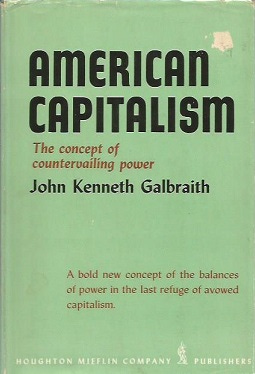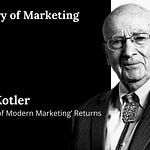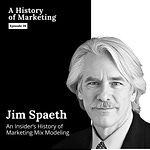A History of Marketing / Episode 13
"Place" might be the most often overlooked of the four P’s in the marketing mix, but it encompasses channels and distribution. Power dynamics and conflicts between companies (and sometimes within them) shape how products reach their customers.
Few have influenced our understanding of marketing channels more than Louis Stern. Lou is the John D. Gray Distinguished Professor Emeritus at Northwestern's Kellogg School and the namesake of the American Marketing Association's Louis W. Stern Award, which recognizes contributions to marketing and channels of distribution.
Lou is also the author of books including Marketing Channels, Management in Marketing Channels, and Marketing Channel Strategy.
Lou drove renewed interest in channels by bringing a fresh perspective. Where prior researchers saw channels as logistics and warehousing, Lou viewed them as dynamic systems governed by power and conflict. Lou brought these insights to clients of his consulting practice which included IBM, Ford, and Johnson & Johnson.
Listen to the podcast: Spotify / Apple Podcasts / YouTube Podcasts
This conversation explores the evolution and strategic management of marketing channels, covering:
How channels evolved from analysis of physical places to corporate strategy
IBM’s consumer PC launch and its failed attempt at operating retail stores
Whether sales or marketing should own distribution
And much more
Now here’s my conversation with Professor Lou Stern.
The Two Critical Issues of Channels: The Amassing of Power and Resolution of Conflict
Andrew Mitrak: Dr. Stern, thanks so much for joining us.
Lou Stern: You're welcome. Good to be here.
Andrew Mitrak: Is it okay if I call you Lou?
Lou Stern: You sure can.
Andrew Mitrak: So, Lou, how would you describe your career in marketing to somebody you're meeting for just the first time?
Lou Stern: Well, I followed a path that not a lot of people do follow. I focused on a subject called marketing channels, but I did it in a very unique way.
Andrew Mitrak: Before we get to marketing channels, how did you get into marketing as a general field to begin with?
Lou Stern: When I was an undergraduate, I took a course in industrial organization economics. Part of that course had two particular readings in it. One was by a professor at Harvard by the name of Joseph Palamountain, and it was called The Politics of Distribution. And it was fascinating. It dealt with the battle between automobile manufacturers and automobile dealers, and how the dealers coalesced in order to make sure that the manufacturers didn't overwhelm them.
The manufacturers were in the mode of overwhelming dealers, and so the dealers felt they had to protect themselves. It also dealt with other industries in which similar battles were taking place. So that was one thing that really sparked interest.
The other was by Kenneth Galbraith, a very famous economist. He wrote a book on countervailing power. The focus was on how retailers square off against manufacturers in order to be able to protect their rights, their properties, and their way of doing business. So those things combined to spark the fire.
As I became interested in marketing channels and got deeper and deeper into the subject, it became obvious to me that the field was really dismal. It was dismal because it was descriptive. It was telling stories of how retailers did things, how wholesalers did things.
And it was focusing on such wonderful topics as, "What's the difference between a one and two-story warehouse?" That has to spark all sorts of fervor in the hearts of men!
I kept saying to myself, how can I make this field much more interesting, particularly for myself? I had no interest in going out and describing the functions of warehouses. I had an interest in having an intellectual pursuit that was something that would stimulate me, but also stimulate all kinds of young scholars coming along behind me.
I discovered that two critical issues in channels were the amassing of power, which I already looked at in industrial organization economics, and the resolution of conflict because there's all sorts of conflict in channels of distribution.
So that led me to all sorts of doctoral students who became interested in the subject, and the rest is kind of history.
Elevating Marketing Channel Strategy
Andrew Mitrak: It sounds like when you were in school, it was almost approached from a mathematical sense, but what you found was that there are all these interesting power struggles.
If you look at a company, how those companies interact with other companies, there are different points in a value chain and distribution where somebody's trying to take more.
Companies face all these decisions: do I work with this partner or that partner? Do I build it myself? And these are all strategic questions that companies make when it comes to their marketing channels and distribution.
Lou Stern: Absolutely. And I would talk to executives about my perspective of channels – how to look at them, how to manage them, how to figure out how to go to the marketplace, how to work with different kinds of distributors. I developed a kind of a framework for that, and I found that they really loved it. They were really enthusiastic about it. The business world ate it up.
They said, "That's where we live, that's what happens to us." We need to be able to understand how to work with these strange people, whether they're suppliers or shippers, or retailers, or manufacturer's reps, or whoever they were.
They needed more schooling on how to look at it, and they needed more schooling from about 30,000 feet. They get so wrapped up in the minutia of channels – and believe me, anybody that's worked in that area in a company understands that – they needed to be able to stand up on high.
Inside IBM's PC Launch and Brief Retail Foray
Lou Stern: So, for example, I got a call from an executive with IBM, and they said, "Professor Stern, we've got an issue that we'd like to discuss with you. We are bringing out something called a personal computer in a very short period of time, and we don't know quite what to do with it."
They knew what to do with it from the point of view of how it functioned, technologically, what it was, but they had very little concept of how to bring it to market.
So they asked me, would I work with them and a consulting firm in Chicago to answer the question? My response to them was, "I wouldn't know a personal computer if I fell on one!”
Right? I have no concept. I surely don't know how to use anything like that.
And they said, "We'll teach you. We'll come up to your place. We'll spend three days with you and teach you how to use the personal computer, we'll give you one, as long as you're willing to spend some time with us and help us think through this issue."
And that was real fun. That was a magnificent time, and we worked together so that they learned how to work with dealers – ComputerLand, Businessland, all those guys sitting out there.
They at one time said, "Should we open our own stores? Should we have IBM stores?" And I said, "If you do, I'm going to throw the computer out the window." I said, "Don't touch it. You guys don't have the mindset to be able to work at a retail level."
IBM did open some stores, but then they closed them almost immediately. So at any rate, that's the kind of fun stuff that I got involved with.
Andrew Mitrak: What an iconic company for such an important time in history.
Who Should Own the Distribution Channel: Marketing or Sales?
Andrew Mitrak: I want to ask you about this example because your books and literature are on marketing channels. Were you working with a marketer at IBM, or was it more of an operations executive or a finance executive? Sometimes these companies didn't even have marketing teams yet. So I'm curious, who was your sort of main point of contact and who were you working with?
Lou Stern: That's a great question, Andrew, because most people don't realize what the answer is. Marketing channels is probably... I don't think an advertising executive in a corporation would know a marketing channel if he fell on one, okay?
Marketing in most corporations – it may have changed some since I was involved – has to do with advertising, product design, all the other Ps, promotion. It doesn't have to do with place or distribution.
The salesforce owns distribution. It's a selling function. I don't agree with it. I believe it's a marketing function. I believe that marketers have to be the people to determine what happens, because all of these things have to be coordinated. You don't just have a marketing channel for the sake of marketing channels; you have one because there's a product that has to be developed and thought about to some extent as you think about what channels it's going to go through.
So the issue is, sales owns it. They shouldn't own it, but they do. And because a salesforce orientation is focused strictly on making sales, they don't think strategically, because they don't get it. And IBM at that time was a salesforce. The salesforce dominated the whole corporation.
Andrew Mitrak: Yeah, if I was to think of IBM up to that point, they were probably selling mainframes, which at that time took up a whole room in an office building. It's a very one-to-one salesperson meeting with an individual company or individual buyer. Maybe they're buying one, maybe they're buying a set for a number of their offices, and it's a very manual install.
When you're launching a PC, it's a personal computer, that's a mass-market product, or supposed to be a mass-market product, and you're dealing with a larger scale.
I think of one way to split marketing and sales: sales is usually more of a one-to-one process, marketing's more of a one-to-many process. If you're IBM going through a retailer like ComputerLand or precursors to Best Buy, you're finding the right channel, the right retailer to reach scale, which is very different than selling a mainframe to a company.
Lou Stern: That's exactly correct. They had a mainframe mental set, and of course, I was not involved with the mainframe end of the business. But figuring out how to use this kind of new consumer product was a real shakeup for them, and they tried very hard to learn what it would take to be much more marketing-focused than they had been in the past.
It wasn't that they were at all a bad company; they were terrific. It was just that they were not used to this new world of marketing channels run the right way, so to speak.
Marketing Beyond Promotion: Channel Focus on How Customers Shop
Andrew Mitrak: If I had a job description for a channel marketer today, the assumption would be that this person's a digital marketing channel manager. They do our emails, they do our website, they do our search engine optimization. Maybe they're doing our paid media. And it's all very focused on the promotion of those four Ps, and it's not thinking about product or thinking about place.
Do you know when that happened? Was there a time when marketing was a little more holistic and less focused on promotion? That doesn't sound like it was the case as much when you were developing marketing channels?
Lou Stern: I suspect that the emergence of Amazon was a hammer that smashed into the heads of many, many folks. The key to getting this focus, to incorporating marketing channels as a mainstream marketing issue that you must take into account just as you take into account products, promotion, and price – the key to it is something that you do all the time in advertising. And that is focusing on the customer, focusing on the end-user.
You have to define your end-user, and you have to then do research to determine how the end-user – whether it's a corporation, or an individual, or some other entity – how that corporation or person likes to shop.
Everybody shops.
And so the question becomes, how do they like to shop? Do they like to shop online? Do they like to shop by going into stores? And it isn't where they want to shop, it's how they want to shop.
There are attributes of shopping. That is, some people need rapid delivery, some people want to see variety. Some people have other issues that are of concern to them as they think about purchasing something. And that focus – the focus of how your customers want to shop – is the key to the kingdom.
And what you know from everything else you learned about marketing is that there isn't one customer. There are lots of customers, and there are lots of customers that fit into segments. So you've got all sorts of different segments out there who like to shop differently.
Oh, wow, hello, right? So eureka! You've found it!
So then the question becomes, how do I deliver those shopping attributes? We call them shopping behaviors. How do I deliver on those? What kind of folk can I employ that will allow these people to shop the way they want to shop? And that's a marketing thing. It takes segmentation-type research.
And then once you've determined how people want to shop and how you'd like to reach them, then you have to manage the thing. Once you set a channel up, you got to manage it, just like you would manage a corporation. Only you may not have the power. Someone downstream may have the power.
You want to try to tell Amazon how to operate? Good luck! Right?!
You won't be able to. But you'll be able to go to Amazon and say to Amazon, "I have found out how customers of yours like to shop for my products. And I want to work with you to enable you to be able to give them what they need." It's a total different mindset. Okay, and that's marketing.
How Lou’s 1977 Textbook Changed How We Think About Marketing Channels
Andrew Mitrak: You wrote the book, Marketing Channels. I think the first edition was in 1977. What change in thinking did that present, and how did companies and academics respond to it?
Lou Stern: What that book did was it gave people who were interested in the subject a vehicle to use in teaching. There was nothing before that, really.
I shouldn't say nothing, there was one book I think, but it wasn't exceedingly popular. But this gave them a kind of a research vehicle. And what I mean by that is it laid out an approach to the subject, which they could then use in their research in attempting to write articles that would be published in learned journals.
So it evolved a whole area – for a while it was relatively hot – called inter-organizational relations and relationships between companies, and then eventually it evolved into something called relationship marketing. Relationship marketing is how do you deal with people – both your customers, your suppliers, your middlemen, whatever, salesforce – how do you deal with them and work with them so that the relationship can be effective? All of this came spawned out of that book. It gave them something as a framework.
And what has to happen is that you have to have theory in academia in order to be able to test it. So if you have a theory about make or buy, that's a big issue. Do you do it yourself or do you get somebody to help you? And there is a wonderful theory called transaction cost economics. It was developed by Ronald Coase at the University of Chicago, Nobel Prize winner, and Oliver Williamson at Berkeley, Nobel Prize winner. They were different eras. Coase started it, Williamson advanced it.
And what transaction cost economics basically says is that it is the transaction costs that make you decide whether you ought to buy or make, whether you ought to vertically integrate your channel of distribution, own the outlets – that IBM question, right? Should we go into the business of retailing or not? And Coase and Williamson argued it's determined by the level of transaction costs, and transaction costs are influenced by the state of opportunism in a channel.
Put bluntly, how much are they going to screw you when you deal with them?
How opportunistic are they? Do they simply look for their own interests and are they willing to take steps to promote their own interests against yours?
That's a very key point because the more opportunism there is, the more transaction costs elevate. So that said that the book, the textbook and the issues that I was trying to address to the whole field – power, conflict, relationships, all of that stuff, trust, you can think of all the issues that go with it – they became fodder for academics.
Breaking Silos: Why Channel Strategy Requires System Thinking
Andrew Mitrak: As I was reading your book, a few things came up for me. I realized I, as a marketer, have such a bias towards thinking about one company or my own company or my own product or my own brands.
When you're on a marketing team, whether you're leading it or a cog in the machine, it's so hard to get even a team aligned around the brand, the growth strategy, the messaging. And when you introduce another company or another partner or another organization, it gets even more complicated.
I have this bias towards thinking single-company. If you ask me to describe a marketing job, I'd probably describe somebody working for a single brand or a single product.
When you wrote this, did other marketers also have that bias, or did this change that for people to think a little more not just about a single company, but about how multiple companies interact with each other to bring something to market? Did that shift thinking in some way?
Lou Stern: Well, anybody that certainly came to my class walked out of the room with that perspective, right? But the idea of relationship and thinking in that term is a pretty difficult one to swallow. It's hard to put it into effect.
You often have to go through the salesforce, and the salesforce is not generally intellectually oriented. It is difficult to make that case when they feel that the distributors are simply sitting in yachts, smoking cigars and living a life of Riley. They have a terrible bias against downstream people.
So, in many cases, it's the great salesman that understands that they're dealing with the system. And in order to be able to deal with the system, the parts have to fit together, and the more they fit together, the better.
Look at Walmart, who's changed their perspective a lot over the years. Their first perspective was to beat the hell out of suppliers, and that's what they did. And I think that what they've learned, especially in their relationship with Procter & Gamble, is that they've learned how to make a system out of their relationship, and they made it a win-win situation for both of them.
Further Reading on Modern Marketing Channels
Andrew Mitrak: Lou, this conversation's been a lot of fun. I'm so glad we were able to do this. If somebody is learning about marketing channels for the first time or has listened to this and wants to learn more about your work, where would you point them? What would you suggest?
Lou Stern: I suggest they get a hold of the ninth edition of my textbook. I'm no longer writing it, but my name is on it. The lead author is a guy by the name of Rob Palmatier. He's at the University of Washington. He is a brilliant guy. It's something that you can read and enjoy parts of it. Just skim around and read what you want.
But don't forget, it's power and conflict that's going to determine whether you're going to win or lose.















